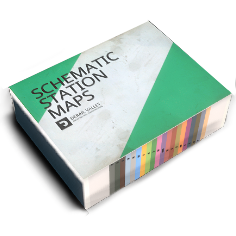Engine & Compression Brake: Difference between revisions
No edit summary |
m Tweaks |
||
| (One intermediate revision by the same user not shown) | |||
| Line 2: | Line 2: | ||
<translate> | <translate> | ||
<!--T:1--> | <!--T:1--> | ||
Engine braking is an alternative way of {{pll|Braking Overview|slowing down}} a {{pll|Rail Vehicle Types| | Engine braking is an alternative way of {{pll|Braking Overview|slowing down}} a {{pll|Rail Vehicle Types|motorized rail vehicle}}, without {{pll|Wheels & Brakes Damage|wearing}} and {{pll|Brake Shoes|overheating the brake shoes}}. It is a property of {{pll|Internal Combustion Engine|internal combustion engines}}, utilized as a type of {{pll|Dynamic Brake|dynamic braking}} on vehicles with a {{pll|Mechanical Transmission|diesel-mechanical powertrain}}. | ||
<!--T:2--> | <!--T:2--> | ||
Disengaging {{pll|Throttle|throttle}} of an engine naturally leads it to drop RPM. However, because the {{pll|Mechanical Transmission|mechanical transmission}} has such a firm link between the engine and the wheels, slowing down of the engine causes the vehicle to slow down too, if the {{pll|Reverser|reverser}} is set in the direction of travel. Selecting a gear where RPM is high gets the most out of an engine brake, and if a train is light enough it will slow down from mere disengagement of the throttle. | |||
<!--T:3--> | <!--T:3--> | ||
Some diesel-mechanical vehicles | Some diesel-mechanical vehicles also come equipped with a compression brake. Typically operated by a lever, this brake functions by modifying the engine exhaust process in a way that creates extra load on the engine, causing it to slow down quicker than it would normally. This supplements the effect of the engine brake. | ||
<!--T:4--> | <!--T:4--> | ||
Disengaged engines exert braking force on the transmission, which may contribute to the {{pll|Powertrain Overheating|warming up of the transmission hydraulic fluid}}. | |||
<!--T:5--> | <!--T:5--> | ||
Monitoring both the transmission fluid temperature, as well as the engine RPM, when using any form of engine braking, is crucial to ensure {{pll|Mechanical Powertrain Damage|safe operation}}. | |||
<!--T:6--> | <!--T:6--> | ||
Engine and compression braking, featured only on some | Engine and compression braking, featured only on some motorized vehicles, does not provide a very powerful braking force for large trains, but it can slow them down over time if used {{pll|Driving Efficiency|tactfully}}. The lower the RPM, the weaker the braking force, and at low enough speeds it can practically have no effect. To bring a vehicle to a complete halt, use {{pll|Braking Overview|braking methods}} that rely on brake shoes. | ||
<!--T:7--> | <!--T:7--> | ||
To operate the throttle, reverser and gearbox again, disengage the compression brake. | |||
</translate> | </translate> | ||
[[Category:Diesel-Mechanical|2]] | [[Category:Diesel-Mechanical|2]] | ||
Latest revision as of 23:21, 17 March 2025
Engine braking is an alternative way of slowing down a motorized rail vehicle, without wearing and overheating the brake shoes. It is a property of internal combustion engines, utilized as a type of dynamic braking on vehicles with a diesel-mechanical powertrain.
Disengaging throttle of an engine naturally leads it to drop RPM. However, because the mechanical transmission has such a firm link between the engine and the wheels, slowing down of the engine causes the vehicle to slow down too, if the reverser is set in the direction of travel. Selecting a gear where RPM is high gets the most out of an engine brake, and if a train is light enough it will slow down from mere disengagement of the throttle.
Some diesel-mechanical vehicles also come equipped with a compression brake. Typically operated by a lever, this brake functions by modifying the engine exhaust process in a way that creates extra load on the engine, causing it to slow down quicker than it would normally. This supplements the effect of the engine brake.
Disengaged engines exert braking force on the transmission, which may contribute to the warming up of the transmission hydraulic fluid.
Monitoring both the transmission fluid temperature, as well as the engine RPM, when using any form of engine braking, is crucial to ensure safe operation.
Engine and compression braking, featured only on some motorized vehicles, does not provide a very powerful braking force for large trains, but it can slow them down over time if used tactfully. The lower the RPM, the weaker the braking force, and at low enough speeds it can practically have no effect. To bring a vehicle to a complete halt, use braking methods that rely on brake shoes.
To operate the throttle, reverser and gearbox again, disengage the compression brake.
